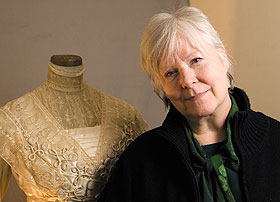  |
| HOME | THIS ISSUE | CALENDAR | GRANTS | BACK ISSUES | < BACK | NEXT > |
Costume design professor helps students fashion their careersby Sherry Fisher - February 2, 2009
|
||||
| One day, Laura Crow and her students are headed to a performance at the Metropolitan Opera. Another day, they’re in Manhattan shopping for fabric. “One of my missions is to make my students less afraid of New York City,” says Crow, a professor of dramatic arts specializing in costume design. “There’s so much available there for them.” No stranger to Manhattan, Crow, who joined the UConn faculty in 1994, has been designing costumes for Broadway, off Broadway, regional theater, film, and opera for more than 30 years. She was resident costume designer for the Circle Repertory Theatre for 13 years. With some 300 productions under her belt, she is perhaps best known for her work with playwright Lanford Wilson and the poetic realism movement in American theater. Crow works with graduate students, who design costumes for UConn’s Connecticut Repertory Theatre. Choosing fabric for a particular costume isn’t easy, she says: “You need to choose the right fabric for the right costume, and that takes a great deal of education. You need to learn how to hold the fabric in your hand, see how it drapes, and feel what we call the hand of the fabric. That’s only learned with experience.” Crow enjoys designing for period plays. She recently worked on The English Channel, a new play by Robert Brustein about Shakespeare and Marlowe during 1593, a plague year in London, when the theaters were closed. “It was fun,” she says. “I liked the fact that I was doing Elizabethan clothing from a modern vantage point.” Crow says proportion is key when designing a costume. “Proportion can make everyone look graceful,” she says. “If you’re designing for an opera star who is more zaftig, you need to design so the proportion is more elegant. Many costume designers don’t teach this to their students.” Shoes are at the top of the list when building a costume, she says. “Sometimes it can take four weeks to find the right pair,” she says. “When we did The Magic Flute at the Bushnell Theatre, the women wore platform shoes with six to eight inch heels. They needed to rehearse in them most of the time. They performed on a raked stage [sloped upwards]. It was asking a lot.” Crow likes to know who is cast before she designs, but that’s not always possible. “In regional theater, often you have to design before you have any idea what the cast is going to be like,” she says. “When I present the designs to the company, I tell them it’s my beginning conceptual idea, and we need to work together. I want them to feel at home in their costumes.”
Trained as a costume historian, dating paintings through historical dress, Crow has spent most of her life studying costume history. “You can date paintings through dress with more precision than through carbon dating and other methods,” she says. “It was an interesting field, but I ended up working in dark, dank museum basements. I missed theater.” Crow’s awards include the Drama Desk, Obie, Villager, Maharam, and American Theatre Wing Awards. She has also been selected five times to be among those representing American Theatre Design at the Prague Quadrennial, a prestigious international theatre design exhibition, and is one of two American designer representatives to the International Organization of Scenographers, Theatre Architects, and Technicians Scenography Commission, where she is head of the costume working group. Several of Crow’s designs are on display in Curtain Call: Celebrating a Century of Women Designing for Live Performance, an exhibit at the New York Public Library for the Performing Arts at Lincoln Center Plaza that runs through May 2. The project showcases the work of more than 100 women who designed sets, costumes, and lighting for theater from 1900 to 2000. Crow teaches courses on comic exaggeration, tragedy and post modernism, film design, and costume history. She also teaches a millinery class, a class on dyeing and painting fabric, and a class in computers and web design. “A visual artist needs to have an excellent web site,” she says. Crow says the costume history class is both her nemesis and her passion. “The students consider it an extremely hard class,” she says, “partly because they don’t have much history background. They have to learn all about world history at the same time they’re trying to learn about social manners, customs and methods of dress.” A book she is writing, An Annotative History of Dress, may help students in that area. With a grant from the United States Institute for Theatre Technology, she is creating a database of visual images for costume historians that will debut in March. |
| ADVANCE HOME UCONN HOME |

